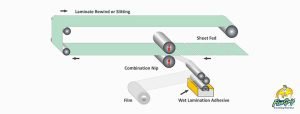
Wet lamination is the process of bonding two or more materials together using an adhesive. One of the most common wet lamination techniques involves using solvent-based adhesives which emit high levels of volatile organic compounds (VOCs). However, water based wet lamination adhesives offer an eco-friendlier alternative.
Water based adhesives for wet lamination utilize water as the carrier instead of traditional solvents like ethyl acetate or methyl ethyl ketone. Reducing dependence on solvent-based products helps minimizes the environmental and health risks associated with VOCs.
Benefits of Water Based Wet Lamination Adhesives:
- Low VOC emissions – Water based adhesives significantly reduce the amount of harmful VOCs released, helping improve indoor air quality.
- Safer for workers – Eliminating exposure to solvent vapors creates a healthier workplace environment.
- Environmental sustainability – Their lower carbon footprint aligns with corporate sustainability goals. This also helps projects qualify for LEED or other green building certification.
- Cuts costs – The lower expenses of water based formulas can cut operational costs without sacrificing performance. This is achieved through reduced ventilation requirements and risks of flammability.
- Versatility – Modern water based products can laminate a wide variety of porous and non-porous substrates including paper, film, foil, and more.
As companies aim to reduce their environmental impact and adopt greener chemistries, water based wet lamination offers an effective alternative. With comparable adhesion and versatility to traditional options, yet enhanced safety and sustainability, more industries are now leveraging water based adhesives for their lamination needs. Continued innovation is expanding the capabilities and applications of water based wet lamination even further.



